Every client who approaches us has a common objective in mind. They expect us to make their website SEO friendly.
How easy or simple it may sound, it’s an exponentially painstaking task. As it requires precision, diligence, and patience.
To create a search engine-friendly website in today’s digital age, that ranks higher on Google search results is what our clients want from us or expect us to deliver quickly.
For them having an SEO friendly website is like having a golden ticket to online success.
But for us, to make such businesses or websites understand the main reason for website SEO optimization is what we consider our first step.
So, here’s the deal: Google handles over 3.5 billion queries every day. That’s an insane figure!
When netizens search for anything, they rely on Google to deliver the most relevant and trustworthy results.
So, if your website needs to be search engine optimized, you’re passing up a huge opportunity to reach your target audience.
Consider this: when your website rises in the rankings of search results, it becomes more apparent to potential visitors.
And we’re not talking about random visitors here; we’re talking about potential clients who are actively seeking what you have to offer.
Furthermore, ranking higher increases your reputation and trustworthiness.
Let’s face it: we tend to believe those websites with high rankings.
But the advantages don’t end there!
In the complex world of the Internet, ranking higher than your competition provides you with a significant edge.
You’ll receive more organic traffic, which implies more potential leads, revenue, or whatever your website’s goal is.
And, unlike other marketing initiatives, search engine website optimization produces long-term results.
Once you are done with site optimization, you’ll continue to reap the rewards with little continuing effort.
As a result, in this blog, we’ll try to answer the question of how to create SEO friendly website and significantly improve website SEO.
Prepare to explode your online presence and leave your competition in the dust!
Let’s get started!
Understanding Search Engine Optimization (SEO)

Now that we’ve established the significance of having an SEO friendly website, let’s go deeper into the world of website SEO optimization.
Let’s begin with What is SEO?
It is the art and science of improving your website’s exposure and organic (non-paid) traffic from search engines such as Google.
Consider it your secret weapon for outperforming your opponents in the digital sphere.
“Why is SEO so important in website development?” you may be thinking.
Here’s the deal: performing optimization SEO is critical in bringing organic traffic to your website.
When someone searches for a certain term or topic, search engines get to work, scouring billions of web pages for the most relevant results.
And where does your website fit into all of this search engine craziness?
Yes, SEO friendly website can definitely help you to climb the ranks and appear on the top page of search results.
What difference does it make?
Studies show that more than 98% of the people never go past the first page of search results, you want to be right there in the limelight.
So, what are the key objectives of an SEO website? Let’s dissect it:
- Visibility
SEO strives to increase the visibility of your website in search engine results. The more eyeballs you draw, the higher you rank.
And, let’s face it, being invisible in the wide web globe will not help your business.
SEO page optimization may make you shine like a star that search engines can’t help but notice.
- Relevance
It is not only about drawing traffic; it is also about attracting the proper traffic.
SEO website design guarantees that you are seen by the correct people – those who are actively looking for what you have to offer.
By optimization SEO, the content and structure of your website can be connected with relevant keywords and themes, creating a match made in search engine heaven.
- Authority
The importance of authority in search engine rankings cannot be overstated.
Websites that are seen as trustworthy, reputable, and authoritative in their particular sectors are favored by search engines.
Site optimization assists you in establishing the authority of your website by generating high-quality backlinks, offering relevant content, and delivering a seamless user experience.
So, buckle up and prepare to embark on an ‘SEO engine optimize journey’.
We’ll reveal the secrets of keyword research, on-page optimization, technological wizardry, and more in the sections that follow.
We’ll traverse the ever-changing SEO friendly website landscape together to improve your website’s exposure, relevance, and authority.
Let’s work together to make your website a real search engine champion!
Keyword Research and Optimization

Conducting Keyword Research
Keyword research in SEO is akin to seeing into the thoughts of your target audience.
It serves as the foundation for your website’s presence in search engine results.
So, let us roll up our sleeves and enter the thrilling world of keyword research!
- Importance of Keyword Research
What better approach to address the question of how to create SEO friendly website than to start with keyword research?
It is critical because it allows you to understand the words and phrases that people use when looking for information, goods, or services online.
You may improve website SEO through your content, meta tags, and other aspects as they coincide with what your target audience is actively looking for by identifying the relevant keywords.
It’s as though you’re speaking their language and offering a suitable answer to their problems.
Here’s an illustration of the significance of keyword research: Assume you own a website that sells eco-friendly yoga mats.
You learn that “sustainable yoga mats,” “non-toxic yoga mats,” and “environmentally friendly yoga mats” are popular search phrases with moderate competition through keyword research.
By strategically including these keywords throughout your website, you enhance your chances of ranking higher and getting organic traffic from those who are especially interested in eco-friendly yoga mats.
Effective Keyword Research Tools and Techniques
You may use the best SEO software suite and approaches available to undertake efficient keyword research. Here are a few examples:
- Google Keyword Planner
This Google free tool is a treasure for keyword ideas.
It gives you information about search volume, competitiveness, and similar keywords, which may help you choose appropriate phrases for your website.
- SEMrush
It would be correct to term SEMrush as one of the best website optimization tools as it provides extensive keyword research tools, such as search volume, term difficulty, and competition analysis.
It also gives useful information about organic and sponsored search trends.
- Moz Keyword Explorer
Moz is also one of the top website optimization tools that provide robust keyword research that includes search volume data, term difficulty scores, and other useful indicators.
It also offers relevant keywords and information about SERP (Search Engine Results Page) characteristics.
- Long tail Keywords
Consider concentrating your efforts on long tail keywords, which are longer and more specialized phrases.
While they may have lower individual search counts, they frequently have less competition and can bring in highly focused visitors.
Instead of targeting the wide term “yoga mats,” for example, you may optimize for “organic cotton yoga mat for beginners.”
Factors to Consider When Selecting Keywords
Consider the following aspects while choosing keywords for your website:
- Relevance
Choose keywords that appropriately describe your website’s content and purpose.
By matching your keywords to the goal of your target audience, you will attract the proper visitors.
- Search Volume
Look for terms that have a high search volume.
While extremely competitive keywords may have huge search volumes, ranking for them might be difficult.
Strike a balance by choosing terms with a high search volume yet low competitiveness.
- Competition
Examine the competition for the keywords you’ve picked.
Highly competitive keywords may necessitate a large amount of effort and time to rank for, especially if your website is new.
For a more balanced strategy, consider targeting a combination of high- and low-competition keywords.
- User Intent
Understand the meaning of each term. Are consumers seeking specific information, goods, or services?
Customize your content to match their demands and add value. Keep in mind that keyword research is a continual activity.
Monitor and adjust your keyword strategy regularly to remain ahead of shifting trends and emerging search phrases.
You’ll position yourself for success in the competitive world of search engine optimization by knowing your audience’s language and aligning your website with their demands.
Stay tuned for the following segment, in which we’ll delve into the art of SEO page optimization to improve your website’s exposure and relevancy in search engine rankings!
On-Page Optimization
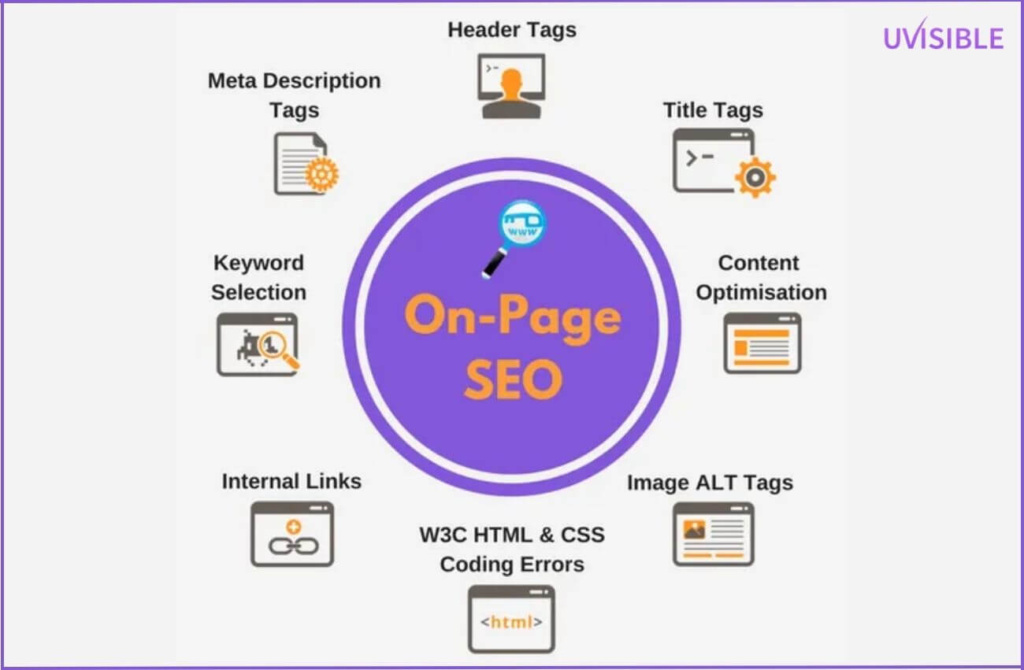
Page Titles
Page names are crucial for both user experience and website SEO optimization.
They are clickable headlines found in search engine results and browser tabs.
Here are some of the reasons why page names are important for SEO:
- Significance
Page titles provide search engines and readers with a brief overview of what to anticipate from a web page.
They look at the page’s content and purpose, impacting its visibility and click-through rates.
- Tips for Writing SEO Friendly Website Page Titles
- Keep it concise: Aim for a title length of 50-60 characters so that it appears completely in search results.
- Be descriptive and relevant: Clearly explain the page’s theme or purpose.
- Include target keywords: To indicate the page’s significance to search engines, include important keywords organically inside the title.
- Best Practices for Incorporating Keywords
- Place keywords near the beginning: Including keywords toward the beginning of a page title can increase their visibility and effect.
- Avoid keyword stuffing: Use keywords in a natural way that does not look spammy. Maintain a healthy mix between optimization and readability.
Meta Descriptions
Meta descriptions are the tiny text snippets that appear beneath the page title in search engine results.
While they have no direct impact on search rankings, they are critical in getting people to click on your website.
When creating appealing meta descriptions, keep the following in mind:
- Role in Search Engine Rankings
Although meta descriptions have no direct impact on rankings, they can have an impact on click-through rates, which in turn affect search engine results.
A well-written and intriguing meta description can persuade readers to visit your website rather than others.
- Writing Compelling and Keyword-rich Meta Descriptions
- Be succinct and informative: Aim for a meta description length of 150-160 characters to guarantee that it appears completely in search results.
- Include keywords: To emphasize the page’s relevance to search queries, use important keywords organically inside the meta description.
- Focus on the value proposition: Highlight the distinct selling features or benefits that customers will receive by visiting your page.
- Create a call-to-action: Encourage visitors to take action by including phrases like “Learn more,” “Discover,” or “Get started.”
Heading Tags (H1, H2, etc.)
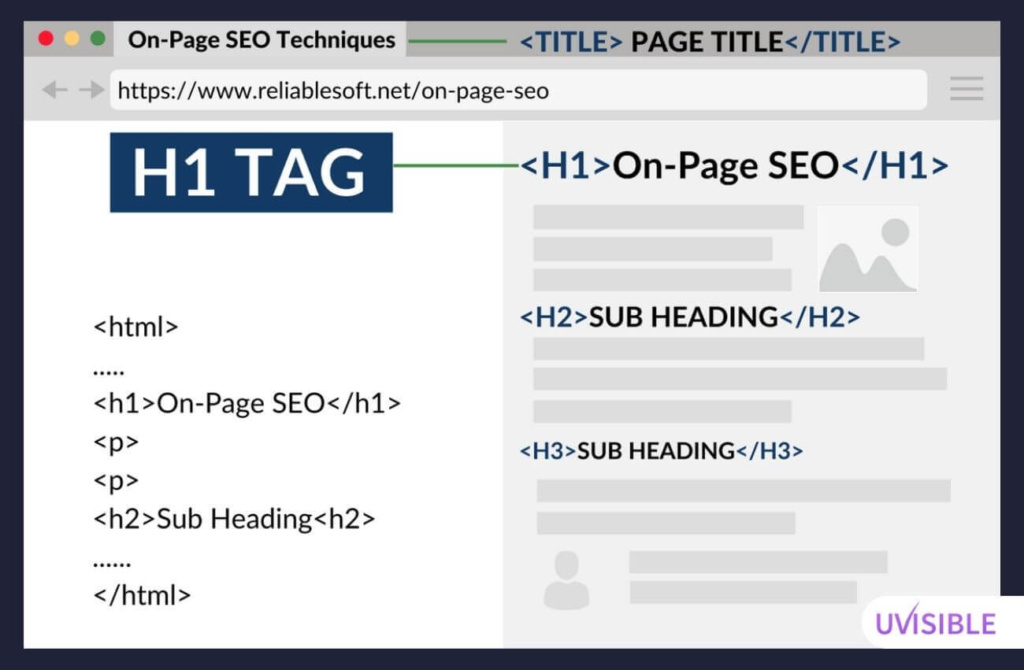
H1, H2, and H3 heading tags are HTML components that establish the organization and hierarchy of material on a web page.
They help with both visual content organization and SEO website content. Here are several reasons why heading tags are important:
- Importance of Heading Tags in Website Structure
- Visual hierarchy: By dividing information into sections and sub-sections, heading tags aid organization and make it more understandable.
- SEO organization: Heading tags are used by search engines to comprehend the context and structure of your content, which might impact results.
- Using Heading Tags Effectively for SEO
- Utilize a single H1 tag per page: The primary heading is represented by the H1 tag, which should appropriately summarise the page’s content.
- Use H2-H6 tags for subheadings: These tags aid in the organization of information into parts and subsections, improving both user experience and SEO.
- Incorporate keywords naturally: While including keywords in heading tags are good, prioritize readability and avoid keyword stuffing.
URL Structure
The URL structure of your website may influence both user experience and search engine results.
Consider the best practices for developing search engine-friendly URLs listed below:
- Impact on Search Rankings
Well-structured URLs that represent the page’s content and hierarchy can have a good impact on search engine results.
- Best Practices for Creating SEO Friendly Website URLs
- Keep them short and descriptive: To describe the page’s content, use clear and succinct keywords.
- Use hyphens as separators: To separate words within the URL, use hyphens instead of underscores or spaces.
- Avoid dynamic parameters: Create static URLs that are straightforward to read and comprehend if at all possible.
- Use lowercase letters: To preserve consistency and avoid any case-sensitivity concerns, use lowercase letters.
Keyword Optimization in Content
Strategic keyword optimization in the content of your website is critical for search engine exposure.
Here’s how to use keywords effectively:
- Strategically Incorporating Keywords
- Focus on user intent: Create material that authentically meets your target audience’s wants and queries.
- Natural language: Write for people, not search engines. Use keywords in your material naturally and appropriately.
- Balance keyword density: Aim for an acceptable keyword density, which should be between 1-2% of the whole text. Excessive keyword repetition might be perceived as spammy.
- Importance of Natural Language and User Experience
- Engage and inform: Make developing relevant, high-quality content that engages people and gives useful information a top priority.
- Enhance readability: To break up the text and improve readability, use headings, subheadings, bullet points, and paragraphs.
- Mobile optimization: Check that your content is mobile-friendly and available on a variety of devices.
You’ll create a solid foundation for on-page optimization by optimizing page names, meta descriptions, header tags, URL structure, and content.
In the next part, we’ll dig into the intriguing area of off-page optimization and the power of backlinks.
Stay tuned as we take your SEO quest to the next level!
Technical SEO Optimization
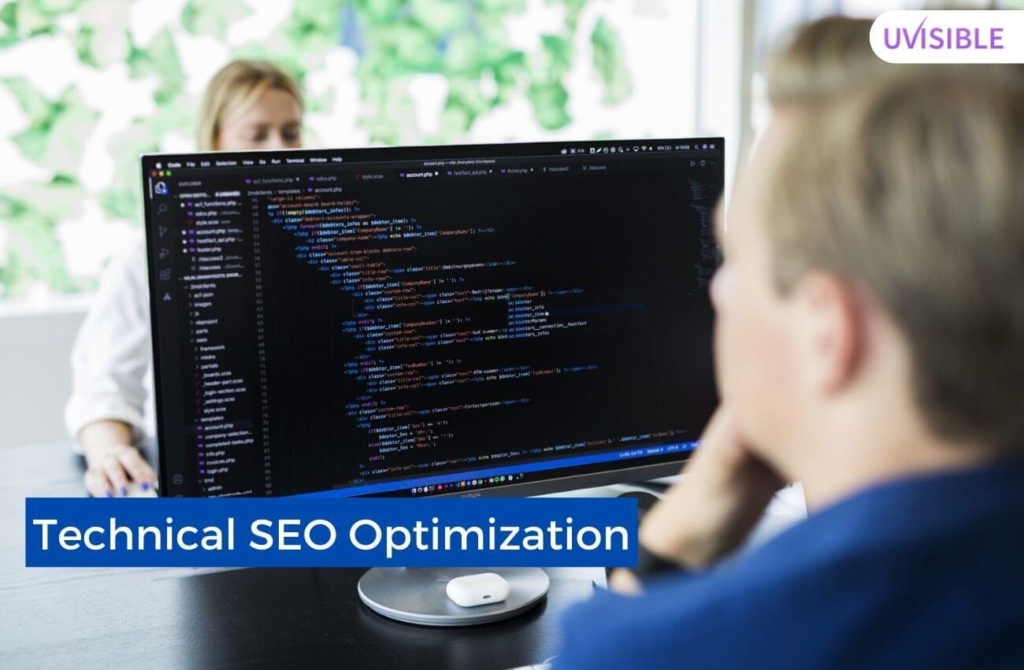
Website Speed and Performance
- Optimizing Page Load Times
Page speed is not only important for user experience, but it also plays an important part in website SEO optimization.
Here are some of the reasons why optimizing page load speeds are critical:
- Impact on User Experience and SEO
- User Experience: According to research, customers expect websites to load quickly, and even a few seconds of delay can result in higher bounce rates and poor user satisfaction.
- SEO Rankings: Page speed is a ranking factor for search engines such as Google. Websites that load faster tend to rank better in search results.
- Methods for Improving Website Performance
- Optimize Image Sizes: Compress and resize photographs to minimize file sizes while maintaining quality. Use proper image formats (e.g., JPEG, PNG) and contemporary image formats such as WebP for additional optimization.
- Enable Browser Caching: Configure caching to save specific portions of your website locally on visitors’ browsers, allowing for speedier subsequent page loads.
- Minify CSS, JavaScript, and HTML: To minimize file sizes and improve load speeds, remove extraneous characters, whitespace, and comments from your website’s code.
- Use Content Delivery Networks (CDNs): CDNs store copies of your website’s contents on servers all over the world, allowing users to access the material from a server that is closer to their location, resulting in speedier load times.
Looking to improve your website performance quickly? Chat with Uvisible Now! We are a dedicated Website Design and Development Agency
Mobile-Friendliness
Given the rising usage of mobile devices, mobile-friendliness has become an essential part of website optimization.
Consider the following suggestions for mobile website optimization:
- Significance of Mobile-Friendly Websites
- User Expectations: Users expect websites to be optimized for mobile devices as mobile usage grows. A negative mobile experience might result in high bounce rates and missed opportunities.
- Mobile-First Indexing: Google now primarily crawls mobile versions of webpages, making mobile-friendliness an important element in search rankings.
- Tips for Optimizing Websites for Mobile Devices
- Responsive Design: Use a responsive design that adjusts to multiple screen sizes and resolutions to provide the best viewing experience on mobile devices.
- Mobile-Friendly Navigation: Make sure your website’s navigation is simple to use on tiny displays, with clear menus and buttons.
- Fast Load Times: Use the previous optimization approaches to enhance website load speeds on mobile devices as well.
- Avoid Flash: Many mobile devices do not support Flash content, therefore utilize contemporary alternatives such as HTML5.
Site Structure and Navigation
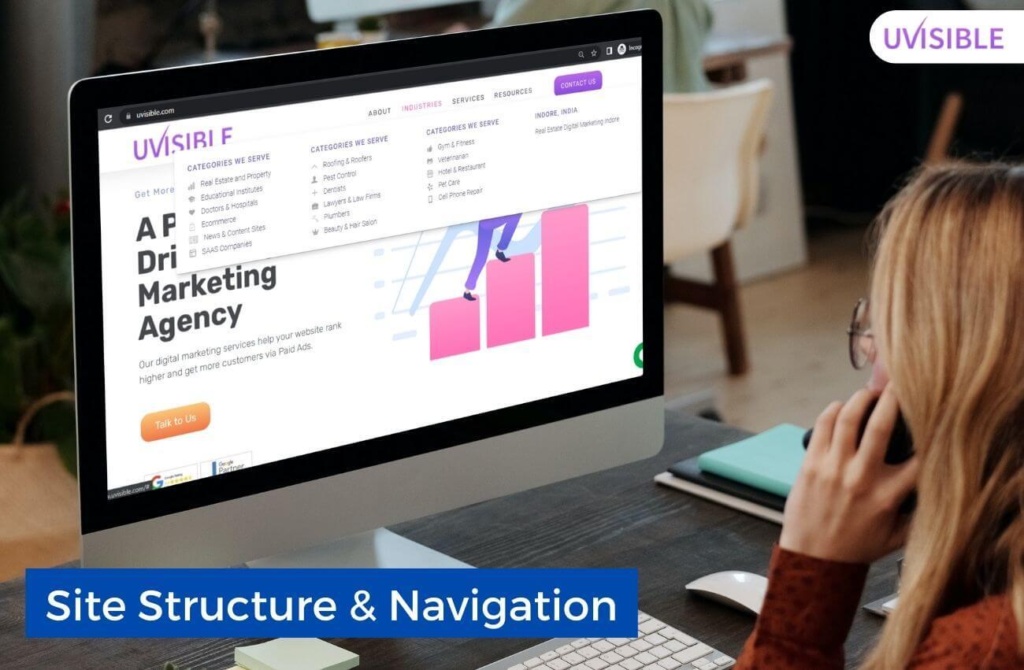
Creating a Logical Site Structure
As a digital marketing agency, we heavily rely on our detailed Technical SEO Audit Service, as it aids us in identifying an effective website structure that is advantageous not only to users but also to search engines.
Here are some of the reasons why a logical site structure is essential:
- Importance of a Well-Organized Website Structure
- User Experience: A clean and logical layout makes it easier for consumers to browse your website, access essential content quickly, and improve their overall experience.
- Search Engine Crawling and Indexing: A well-structured website enables search engine bots to grasp the relationships between your website’s seen various pages and information, which aids in crawling and indexing.
- Creating a Logical Hierarchy for Easy Navigation
- Categorize and Group Content: Create a hierarchical structure by organizing your website’s content into logical categories and subcategories.
- Use Descripessential: Include relevant keywords in your URLs to help both people and search engines comprehend the page’s content.
Check Out! SEO Terminologies
Internal Linking
Internal linking is the process of connecting one page of your website to another inside the same domain. It has various SEO advantages:
- Benefits of Internal Linking for SEO
- Enhances Website Navigation: Internal links let people traverse your website more easily, increasing their experience.
- Distributes Link Equity: Internal links assist in dispersing your website’s authority and ranking power across multiple pages, increasing their exposure in search results.
- Determines the Relevance of the Content: By connecting similar pages, you indicate to search engines the significance and connectivity between different areas of your website.
- Tips for Effective Internal Linking Strategies
- Use Descriptive Anchor Text: Use relevant and descriptive anchor language that appropriately reflects the content of the linked page.
- Prioritize Relevance and Context: Link to contextually relevant pages and give users additional value.
- Utilize Site-wide Navigation: Include crucial pages in your website’s navigation menus or footer to guarantee adequate internal linkage.
XML Sitemap
An XML sitemap is a file that contains all of your website’s URLs, assisting search engines in understanding its structure, content, and site optimization.
Here are some of the reasons why XML sitemaps are crucial:
- Purpose of an XML Sitemap
- Crawling and Indexing: An XML sitemap serves as a roadmap for search engines, ensuring that all pages are found and indexed.
- Prioritizing Pages: Within the sitemap, you may designate the significance and priority of certain pages, instructing search engines on which pages to crawl and index more often.
- Creating and Submitting a Sitemap to Google
- Generate an XML Sitemap: To generate an XML sitemap for your website, use online sitemap generators or plugins.
- Submit to Google Search Console: Sign up for Google Search Console and upload your XML sitemap to help Google better understand the structure of your website and index it.
You may improve the technical features of your website and its exposure on search engines by optimizing website performance and speed, guaranteeing mobile-friendliness, building a logical site structure, utilizing internal linking, and adopting a strategic approach when it comes to how to create a sitemap.
The value of high-quality content and its influence on SEO will be discussed in the next section. Keep an eye out!
Content Creation and Optimization

High-Quality and Relevant Content
a. Emphasize the importance of High-quality, Valuable Content
In the digital world of today, a good SEO friendly website is built on high-quality, relevant material.
Search engines want to give people the best results possible, so they give more weight to websites with useful and interesting information.
Here’s why it’s important to have good content:
- User Satisfaction: When people find your material useful, interesting, and full of useful information, they are more likely to stay on your website for longer. This lowers your bounce rate and increases your chances of making a sale.
- Search Engine Credibility: Search engines want to give people information that they can believe. By making high-quality content regularly, you build trust with search engines, which leads to better search results.
- How to Conduct Content Audits and Improve Existing Content
It’s important to regularly audit your content to make sure it’s still useful and relevant to your audience.
Here are some steps to conduct a content audit and improve your existing content:
- Identify Your Goals: Find out what your content is for and make sure it fits with the goals of your website. Make sure your material has a clear goal, whether it’s to teach, entertain, or persuade.
- Assess Content Relevance: Check to see if the material you already have is relevant to your target group. Find information that is out of date and needs to be changed or taken away.
- Improve Readability: Make sure your material is clear and easy to read. To organize information, use clear headers, subheadings, and bullet points. Use short words and breaks between long texts.
- Enhance Visual Appeal: Add things that are nice to look at, like pictures, maps, and movies, to improve the user experience. Visual material makes it easier to explain complicated ideas.
- Optimise for SEO: Review your material to make sure it is SEO-friendly. Make sure your writing has a natural flow and that your goal keywords are used strategically.
Keyword-Rich Content
- Discuss the significance of keyword-rich content for SEO
When it comes to search engine website optimization, keywords are very important.
When you use relevant terms to optimize your content, it helps search engines understand what your content is about and why it is important.
Here’s why it’s important to have material full of keywords:
- Improved Visibility: By focusing on important keywords, you can make it more likely that your website will show up in search engine results for questions that are similar. This makes your website easier to find and brings in natural traffic.
- Better User Experience: When you use keywords in your writing in a normal way, it helps people find the information they want. It makes the whole user experience better and keeps people interested.
- Guidelines on Optimizing Content with Target Keywords
Follow these rules if you want to successfully optimize your content with goal keywords:
- Keyword Research: Start by doing a thorough keyword study to find keywords that are relevant to your business and work well. To find good terms, use website optimization tools like Google Keyword Planner, SEMrush, or Ahrefs.
- Strategic Placement: Put your goal keywords in your text in a way that makes sense. Put them in the title of the page, the headings, the subheadings, the first line, and the text itself. But don’t use too many keywords, as this can hurt both user experience and SEO.
- Natural Language: Use natural English that works well for your readers when you write your content. Don’t force words or phrases into sentences. Instead, you should focus on making content that is useful and interesting and that easily includes the keywords.
- Long Tail Keywords: They are better because they are more detailed and have less competition. Long tail keywords can help you reach a more specific audience and improve your chances of ranking better for those specific search queries.
Optimizing Images and Multimedia
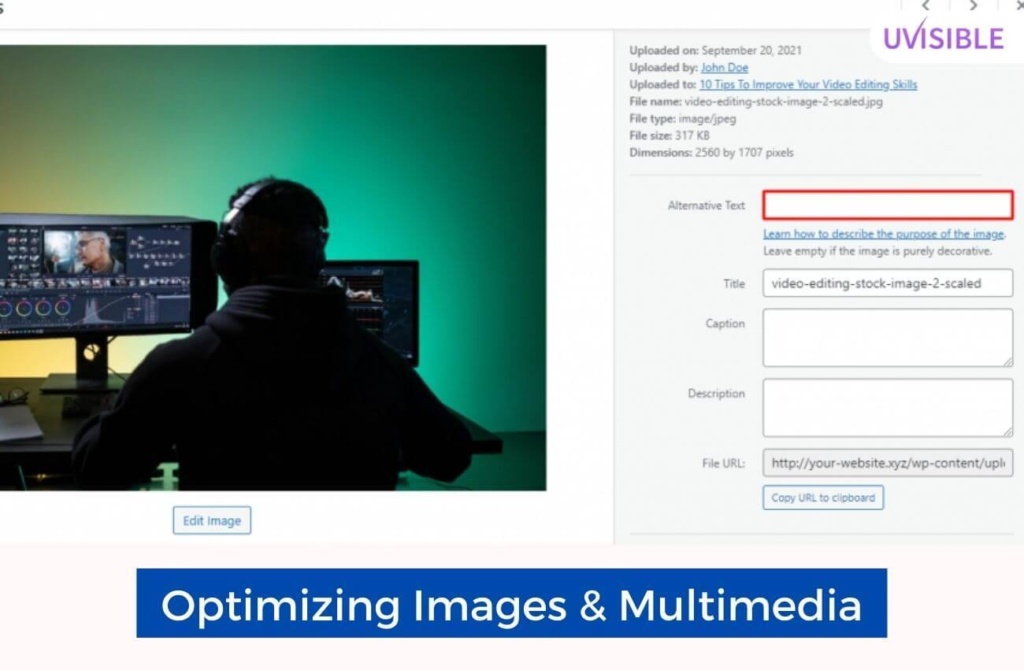
- Explain how to Optimize Images for Better Search Engine Visibility
Images and other video features are essential for making your website look better.
Here’s how you can improve their exposure in search engines:
- Image Compression: Reduce the file size of your pictures without hurting their quality by compressing them. This will help your website load faster. Use tools like Kraken.io or TinyPNG to reduce the size of your pictures.
- Alt Tags: Add alt tags to your pictures that are clear and full of keywords. Alt tags help search engines figure out what your pictures are about and make them easier for people to see. Use terms that are related to the picture, but make sure they accurately describe it.
- Image File Names: Give your picture files names that are clear and include keywords that describe them. Instead of using names like “IMG001.jpg,” use names like “seo-friendly-website-checklist.jpg” that explain what the picture is.
- Captions and Image Context: When it makes sense, put notes or other information around your pictures. This helps search engines figure out what your pictures are about and why they are there.
By optimizing your images and multimedia elements, you improve the general user experience and make your website more appealing to both viewers and search engines.
Don’t forget to back up your content with appropriate data, facts, or numbers.
For example, you could say that websites with high-quality content get 126% more leads than those with average content, or that pages with optimized pictures have a better chance of ranking in image search results.
Also Read: SEO Image Optimization Guide
Off-Page SEO and Link Building
- Building High-Quality Backlinks
- Significance of Backlinks in SEO
Backlinks are an important aspect of establishing a website’s authority and reliability. They are very important in off-page SEO.
Backlinks are significant for the following reasons:
- Search Engine Rankings: Backlinks from other websites are seen as “votes of confidence” by search engines. Websites having a greater number of high-quality backlinks perform better in search engine results pages (SERPs).
- Increased Organic Traffic: Backlinks serve as conduits for organic traffic to your website. When credible websites link to your material, your chances of receiving relevant people who are more inclined to engage with your content grow.
- Obtain High-quality Backlinks using Ethical Means
- Create Valuable Content: Concentrate on producing high-quality, educational, and interesting content that will automatically draw or outsource backlinks from other websites. Others are more inclined to connect to content that gives unique insights, useful suggestions, or original research.
- Outreach and Networking: Establish ties with relevant websites, bloggers, and influencers in your field. Offer to write guest articles or work together on content projects. This might result in organic backlinks to your website.
- Influencer Partnerships: Collaborate with industry experts or influencers to develop meaningful content. When people share or link to the piece, it can enhance your backlink profile dramatically.
- Broken Link Building: Identify broken links on relevant websites and contact the site owners to let them know. Provide value to both parties by offering your material as a substitute for the broken link.
- Social Media and Online Reputation Management

- Social Media and SEO
While social media signals do not directly influence search engine results, they do play an indirect function in SEO.
Here are some examples of how social media might affect your online presence:
- Increased Brand Visibility: Social media networks allow you to display your business and reach a larger audience. People who interact with your material on social media can enhance brand awareness and recognition.
- Social Sharing and Amplification: When you publish your material on social media, it gains attention and may draw backlinks from other websites. Search engines use social signals as indicating that your material is important and worth consideration.
- Provide Tips for Managing Online Reputation and Leveraging Social Media
- Monitor Brand Mentions: Monitor online references of your brand regularly to handle any bad feedback or difficulties as soon as possible. Google Alerts and social media monitoring tools can assist you in staying updated.
- Engage with Your Audience: Respond to social media comments, messages, and reviews in a timely and professional manner. Engaging your audience fosters trust, boosts brand reputation, and may result in good online reviews.
- Consistent Brand Messaging: Keep your brand’s voice and messaging consistent across all social media channels. This aids in the development of a strong brand identity and awareness.
- Encourage Social Sharing: Include social sharing icons on your website to make it simple for users to share your material on social media sites. This can result in improved visibility and perhaps backlinks.
Include numbers, facts, and figures to back up your claims.
You may say that websites with a strong social media presence are 3.5 times more likely to obtain backlinks, or that 90% of people read online reviews before visiting a shop.
Want to skyrocket your Social Media game? Chat with Uvisible NOW! We are the best Social Media Marketing Agency!
Analytics and Monitoring
- Setting up Google Analytics
- Benefits of using Google Analytics for tracking website performance
- Comprehensive Data Analysis: Google Analytics delivers detailed information on your website’s traffic sources, user behavior, conversion rates, and more. It assists you in better understanding how people interact with your website and identifying areas for development.
- Goal Monitoring: In Google Analytics, you may create particular goals, such as making a purchase or submitting a contact form. Tracking these objectives helps you to assess the efficacy of your marketing activities and the performance of your website.
- Audience Segmentation: Google Analytics allows you to segment your audience based on demographics, behavior, or acquisition source. This segmentation assists you in comprehending various user groups and tailoring your marketing strategy accordingly.
- Setting up and configuring Google Analytics
- Sign up for Google Analytics: Create a Google Analytics account by going to the Google Analytics website and signing up. You must include your website’s URL as well as other essential information.
- Get your Tracking ID: Google Analytics will provide a tracking code snippet when you join up. Insert this code into the header area of each page of your website.
- Configure Goals and Funnels: In Google Analytics, create objectives and funnels to measure particular activities or conversions on your website. You may, for example, track the number of newsletter sign-ups or transactions made.
B. Monitoring SEO Metrics
- Essential SEO Metrics to Track for Website Optimization
- Organic Traffic: Keep track of the number of people who arrive at your website via organic search. This indicator assists you in determining the efficiency of your SEO activities and identifying any changes in search visibility.
- Keyword Rankings: Keep track of how your target keywords rank in search engine results. This allows you to assess the visibility of your website and make required changes to enhance rankings.
- Bounce Rate: The percentage of visitors that leave your website after reading only one page is referred to as the bounce rate. A high bounce rate might indicate problems with website usability or content relevancy.
- Analyze and interpret data from Google Analytics
- Audience Overview: Understand your website visitors’ demographics, interests, and behavior. Determine patterns and trends that can assist you in refining your target audience and tailoring your content.
- Behavior Flow: Examine how people interact with your website and look for possible drop-off areas. This allows you to improve website SEO the structure of your website and increase user experience.
- Conversion Tracking: Monitor the effectiveness of your marketing initiatives and the conversion rates of certain activities on your website. This information assists you in identifying areas for development and optimizing your conversion funnel.
Include numbers, facts, and figures to back up your claims. You may say, for example, that websites with Google Analytics installed earn 2.7 times more conversions, or that 80% of marketers consider Google Analytics critical to their digital marketing campaigns.
Conclusion

As we conclude this article, ask yourself: Are you ready to improve your website’s search engine visibility? Will you put the strategies we’ve discussed into action? Have you got the anwer to the question of how to create SEO friendly website?
So, let’s recap some of the key points we’ve covered:
- Importance of having a SEO friendly Website
- Role of SEO in Website Development
- Keyword Research and Optimization
- On-page Optimization
- Technical SEO Optimization
- Content Creation and Optimization
- Off-page SEO and Link Building
- Monitoring and Analytics
But keep in mind that wesbiite SEO optimization is a continual effort. It necessitates constant monitoring, data analysis, and adaptation to changes. So, use everything you’ve learned to make your website stand out in search results.
Are you ready to go forward? Implement these tactics, monitor your success using tools like Google Analytics, and watch your website grow.
Let’s embark on this optimization SEO journey together and achieve success in the ever-evolving world of search engines.
So go ahead and unleash the power of your website and if you are still in any sort of dilemma try connecting with UVISIBLE your one-stop solution for all your digital marketing needs!
About us and this blog
We are a digital marketing company with a focus on helping our customers achieve great results across several key areas.
Request a free quote
We offer professional SEO services that help websites increase their organic search score drastically in order to compete for the highest rankings even when it comes to highly competitive keywords.
Subscribe to our newsletter!
More from our blog
See all postsRecent Posts
- Landing Page Copy That Converts – Secrets Revealed December 16, 2024
- Understanding MTD, YTD, QTD, MoM, and YoY Metrics: A Comprehensive Guide December 12, 2024
- Learn How to Rank High on Google My Business: Guide to Master Local SEO December 7, 2024









Pingback: Why are Backlinks Critical for your Website’s SEO Success? - Uvisible
Pingback: Franchise SEO Strategy and Best Practices - Uvisible
Pingback: Why SEO eCommerce is Important? - Uvisible
Pingback: The FREE SEO Audit Trap: What They're Not Telling You - Uvisible
Pingback: Evergreen Content: What it is and Why You Need it? - Uvisible